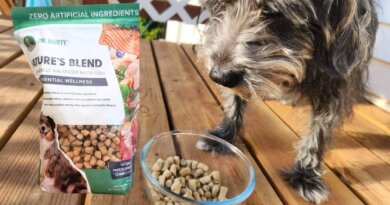Dog Food for Senior Dogs
[ad_1]
I just used WDJ’s new searchable dry dog food database to look for potential new foods to feed my 14-year-old dog, Otto. One goal when feeding most senior dogs is to find a food with a moderate amount of high-quality protein. I used the “minimum protein content” column to help me zero in on the foods that contain the amount of protein I want to feed Otto, and then looked at the ingredients of each of the candidate foods. All of that information, organized for you (and me!) in one handy place!
But allow me to explain those italicized terms a bit.
Protein levels in Dog Food: Low, high, moderate
The minimum requirement for crude protein in an adult dog maintenance diet is 18% on a dry matter basis, which (assuming an average moisture content of 10%) is 16.2% “as fed” (as it is in the package). The minimum requirement for crude protein for dogs in a “growth/reproduction” phase (or “all life stages,” which includes puppies and moms) is 22.5% dry matter, which is 20.25% “as fed” (assuming 10% moisture).
The Association of American Feed Control Officials (AAFCO) does not state a maximum level for protein.
We’d define “moderate” as something near the midpoint between the legal minimum and the highest amount of protein you can find in any dry dog food on the market.
Using the WDJ searchable database of approved dry dog foods, you can click on the top of the “minimum % protein content” column to make all the 1,100-plus foods appear in order by protein content. When ordered so that the foods with the lowest amount of protein appear at the top, you’ll see just a few products with just 17% and 18% protein – and these are mostly “weight control” foods. (However, a few of them are labeled as being appropriate for senior dogs, which, in our opinion, is sad. Senior dogs definitely need more protein than the minimum allowed.)
By clicking on the top of that column again, so that the foods with the highest amount of protein appear at the top, we can find products with very high amounts of protein in them, with numbers in the low 40s (43%, 42%, 41%).
The exact midpoint, in this case, is 30%. We think this is a good, moderate amount of protein for most senior dogs.
Note that there are more opinions about protein levels in dog food than there are veterinary nutritionists. This shouldn’t be a surprise; there is little consensus among experts in human nutrition about ideal protein levels, too.
Older veterinarians tend to regard foods with even moderate protein levels as potentially dangerous, or, at a minimum, a waste of money. When you feed a lower-protein diet to a dog, you decrease the amount of nitrogenous waste delivered to the kidneys for excretion in the urine; it was speculated that one could preserve the dwindling kidney function of dogs with chronic kidney disease by giving their kidneys less work to do (by feeding a lower-protein food to the dog).
However, according to veterinary nutritionists Andrea Fascetti and Sean Delaney, “the effect of protein restriction on the progression of renal damage in dogs and cats remains controversial and no definitive study exists on this matter.” (Quoted from “Nutritional Management of Chronic Renal Disease” on the website for the UC Davis School of Veterinary Medicine.)
While it’s been demonstrated that some dogs with chronic kidney disease improve when their dietary protein is moderately restricted, this has frequently (and tragically, in our opinion) been extended to all older dogs, whether or not they have any kidney problems at all. Today, it’s well-accepted that most older dogs actually benefit from diets that contain more protein – as long as it’s a high-quality protein – than young adult dogs.
However, there is newer evidence, based on newer criteria, very high protein dog food diets is potentially harmful for dogs to eat. (See this post by Linda Case, MS, Canine/Feline Nutrition, for details.) This give us even more confidence in our advice to look for foods with moderate protein levels.
SUBSCRIBERS ONLY: Whole Dog Journal’s 2022 Approved Dry Dog Foods
What constitutes a high-quality protein?
Broadly speaking, the quality of a protein depends on its digestibility and its amino acid profile – that is, whether it contains adequate amounts of the amino acids that dogs require. In general, animal-sourced proteins contain more of the amino acids that are essential to dogs (and they are supplied in proper ratios for benefitting dogs) than do plant-sourced proteins.
The digestibility of ingredients depends on a number of factors, too numerous to explain here. (If you’re especially curious, read Linda Case’s 2017 piece for WDJ about digestibility here.) The bottom line: Pet food companies typically conduct digestibility studies on their finished products; they should know how digestible their products are, and they should be able to furnish consumers with that information. We should all be asking for this information!
A final thing to keep in mind
The amount of protein listed on a dog food label is the guaranteed minimum present in the food. It may contain much more! To be certain, ask the company for the amount of protein in their products – a number from an actual nutrient analysis.
[ad_2]
Source link





best online pharmacy india https://indiapharmacy24.pro/# – reputable indian pharmacies indiapharmacy24.pro
stromectol brand https://stromectol24.pro/# stromectol tablets 3 mg stromectol24.pro
“Statimira – ваш ключ к пониманию сложных рыночных динамик.”
“Statimira Economic Indicators: Следите за Ключевыми Показателями”
buy atorvastatin 80mg pills lipitor 80mg pills lipitor 40mg generic
order proscar 1mg online purchase forcan pill order diflucan 100mg online
buy baycip medication – bactrim price buy amoxiclav sale
ciprofloxacin 500mg canada – trimethoprim oral buy clavulanate sale
order metronidazole 400mg online cheap – buy amoxicillin pills for sale zithromax 500mg price
cost ciprofloxacin – chloramphenicol sale erythromycin sale
valacyclovir ca – brand diltiazem 180mg generic zovirax
stromectol 2mg – order aczone online cheap tetracycline order online
flagyl 400mg uk – order cefaclor 250mg sale buy azithromycin 500mg pill
where to buy ampicillin without a prescription purchase monodox pill amoxicillin pills
buy furosemide pill diuretic – order atacand 16mg online purchase capoten online
glucophage online order – order combivir lincomycin 500 mg tablet
zidovudine tubes – buy zyloprim generic buy zyloprim 100mg online cheap
clozapine 100mg without prescription – purchase amaryl sale oral famotidine 40mg
quetiapine 100mg usa – order zoloft 50mg for sale buy generic eskalith
order anafranil generic – buy generic doxepin 75mg cheap doxepin 75mg
buy hydroxyzine generic – purchase fluoxetine pill buy endep no prescription
amoxil drug – keflex price purchase cipro online
purchase amoxiclav for sale – myambutol order online ciprofloxacin uk
order cleocin 300mg sale – buy terramycin without a prescription purchase chloromycetin
order azithromycin pill – order generic tinidazole 500mg buy ciprofloxacin pill
ivermectin 6mg for humans for sale – purchase cefaclor generic cefaclor pills
ventolin oral – fluticasone over the counter theo-24 Cr over the counter
clarinex oral – ventolin 4mg pill albuterol 2mg inhaler
buy generic medrol – buy azelastine 10 ml nasal spray order azelastine sprayer
glyburide 2.5mg tablet – buy pioglitazone 15mg generic buy dapagliflozin no prescription
repaglinide 1mg for sale – buy generic jardiance for sale buy empagliflozin 25mg
buy lamisil 250mg for sale – griseofulvin price grifulvin v online buy
order semaglutide 14mg generic – order semaglutide 14mg for sale buy DDAVP for sale
order ketoconazole 200 mg generic – cost ketoconazole order itraconazole online cheap
buy generic famciclovir – famciclovir generic cheap valcivir
lanoxin 250 mg uk – dipyridamole 25mg usa buy generic lasix 40mg
hydrochlorothiazide brand – order microzide pill buy generic bisoprolol 10mg
metoprolol cost – order telmisartan 80mg sale nifedipine 30mg usa
nitroglycerin online – valsartan 160mg drug diovan order
rosuvastatin online stool – zetia talent caduet buy think